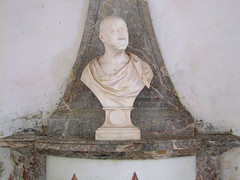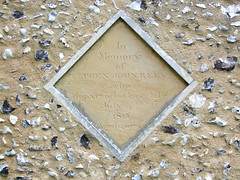| |
|
St Mary,
Narford
 |
|
The
church of a village which has disappeared,
begins Pevsner, but of course there are dozens of
churches in a similar situation, many of them in
Norfolk. There seems to have been no great
disaster, no mass clearance by a landowner.
Narford was big enough in the 14th Century to be
granted the status of a market. But then the
village quietly and simply got smaller, a process
accelerated after the start of the 18th Century
when the entire estate was purchased by the
Fountaine family, for whom agriculture does not
seem to have been a priority. By 1851, when the
population of rural East Anglia was reaching a
peak, there were barely a hundred inhabitants,
and there are probably no more than twenty today.
When Munro Cautley visited in the 1930s, he found
this little church in the park in a very
neglected state. The church has had its ups
and downs since, falling into disuse after a
post-war restoration, but it is now in the care
of the Norfolk Churches Trust, and as part of the
combined parish of Narborough and Narford still
holds regular services. |
However,
anyone visiting today will, I'm afraid, still feel it is
a woefully neglected place. This is partly due to the
series of lead thefts the building has suffered over the
last couple of years. Anyone coming here can see very
clearly the enormous damage that this current wave of
thefts is doing to the heritage of England. Quite simply,
one of the most significant manifestations of our way of
life as a nation over the last thousand years is being
very quickly destroyed. It is a disaster. Locking the
churches will not help.
To get to Narford church you have to use the customary
church way across private land. By law, there has to be
reasonable access to a parish church even if it is not
directly accessible by normal means. However, this is
slightly complicated at Narford because the church was
declared redundant. As recently as the first years of the
21st Century, a friend of mine had to be escorted to the
church by the Rector of Narborough, because of the
hostility of the landowners to visitors. When Pevsner's
revising editor Bill Wilson came this way in the late
1980s, he was forbidden access to the church. But now
some agreement has been reached, and you can walk, though
not drive, to the church. It is not far, about a quarter
of a mile. The church sits in an idyllic setting between
the great ornamental lake and the even greater and more
impressive pile of Narford Hall.
Narford Hall is famous for all sorts of reasons. When the
Fountaine family bought the estate in the early 18th
Century, they built one of the great houses of the age,
furnished and decorated inside by the likes of Giovanni
Pelligrini. Successive Fountaines were antiquarians and
collectors, devoting their time and money to bringing
together great art treasures from around the world and
furnishing the house in an outstanding fashion.
What makes it all the more fascinating is that, since the
mid-20th Century, very few people have been allowed in to
see it. Pevsner's revising editor certainly wasn't.
However, Pevsner was, albeit briefly, and we know this
because of John Harris's wonderful and funny book No
Voice From The Hall: Early Memories of a Country House
Snooper. After years of trying to see inside, Harris
was finally granted permission in 1960 on the condition
to which all visitors had to agree, no photography. He
describes the eccentric Louisa Constance Catherine
Fountaine, in an ostrich-feather dress and an
ostrich-feather hat which covered her face, and the
great Pelligrini painted hall, piled high to the
ceiling with what appeared to be mostly unopened copies
of the Times, the later ones just thrown to the top of
the heap. In fact, Harris and Mrs Fountaine got on
very well, and she proved very knowledgeable, but during
their tour there was another knock at the door.
"I am not expecting anyone," said Mrs
Fountaine. The maid returned to report. "A man and a
woman with a clipboard, Mum. Maybe from the Council,
perhaps to read the meter." "I'd better see
them," said Mrs Fountaine. "I didn't think they
worked on Saturdays.' There is a ripple of amusement on
our part when the maid announces "it's a Dr and Mrs
Pevsner asking to see the house. From the Buildings
Council.' In come Nikolaus and Lola, she indeed with a
clipboard in hand. I wondered if there could be anything
more off-putting to the landed classes than to arrive at
the front door looking as though you'd come to read the
meter.
Mrs Fountaine's husband Vice-Admiral Charles Fountaine
had been a Naval ADC to King George V, and their son
Andrew was probably the most infamous of the 20th Century
Fountaine eccentrics. Born in 1918, he had fought as a
teenager on the side of Franco in the Spanish Civil War,
before signing up as an ordinary seaman in the Second
World War. Before the end of the War he had been
appointed a lieutenant-commander. After achieving a First
in Chemistry at Cambridge, he became an active member of
the Conservative Party, the ordinary route into politics
for a member of the East Anglian landowning class, and
even stood for parliament, but was eventually disowned by
the party for his increasingly bizarre and anti-Semitic
speeches. In 1960 he became a founder member of the
British National Party, a far more radical party than the
one with the same name today. Its paramilitary wing,
Spearhead, used the Narford Hall estate for training with
guns and for its annual British Aryan camp which
attracted followers from all over western Europe.
The original British National Party was one of the groups
which came together to form the National Front, of which
Fountaine was a leading member. He stood as candidate for
Norwich South in 1979, but increasingly became
disillusioned by the bitter infighting between the old
guard, of whom he was one, and the increasing number of
younger populist neo-Nazis who would eventually split to
form the British Movement. After getting just 0.7% of the
vote in Norwich South, Fountaine retired from politics, to
concentrate on growing trees, as his wikipedia entry
quaintly puts it.
This, then, is the background against which you approach
Narford church. The churchyard is bounded by new metal
railings, but it is very easy to see into the park and
ornamental gardens beyond. The church rides the
churchyard like a ship in a storm, because the great
mound that covers the Fountaine mausoleum swells against
the north side of the chancel. The tower was rebuilt in
1857 in memory of Charlotte Fountaine, who had died
young. The inscription around the top records her
husband's fondness for her in a pleasing manner.
You step inside to a scene of near-dereliction. The walls
are black with water, and the stone floor green. The
large memorials in the north aisle are covered in plastic
sheeting to protect them until such a time as the roofs
can be replaced. There are just four benches in the short
nave, facing each other in college chapel fashion. The
chancel beyond is raised.
It is a
haunting place. It would be hard to stand in here and not
be affected by it. The two grand memorials at either end
of the south aisle recall the wealth and influence of the
18th Century Fountaines. Sandwiched between the traumas
of the 17th Century and the energy of the 19th Century,
it was the landowners of the 18th Century who had every
reason to think that their world was permanent and
unchanging, that the world would always be as they knew
it. Collecting art, tinkering with primitive science and
technology, dispensing benevolent largesse to the poor on
their estate - it is a world that is at once attractive
and appalling.
In the north wall of the chancel is
a tomb recess, 13th Century presumably, although its
knight has disappeared. The stone arm rest on the sedilia
is a curiosity.
In the north aisle, an
elegant ledger stone of 1740 tells us that its
inhabitant was A Good Companion and an
Honest Friend, Rare Virtues in this Age, &
hear they End. At the east end of the north
aisle, something has happened. The bricks that
filled the entrance to the Fountaine crypt have
come loose and fallen away, possibly because of
the water ingress. You can see down the stairway
into the vault, the wooden Fountaine coffins set
in the alcoves. One facing the stairway has a
coffin plate which reads CF died Aug 9th 1857.
This, then, is the Charlotte Fountaine who died
young, and for whom the tower was rebuilt.
Outside to the north of the church overlooking
the ornamental lake and the gardens are the
memorials to the 20th Century Fountaines, among
them Andrew Fountaine, who died in 1997. And
beyond the lake, the wind ripples hundreds of
young birch trees in the new plantation. |
|
 |
|
|
|
